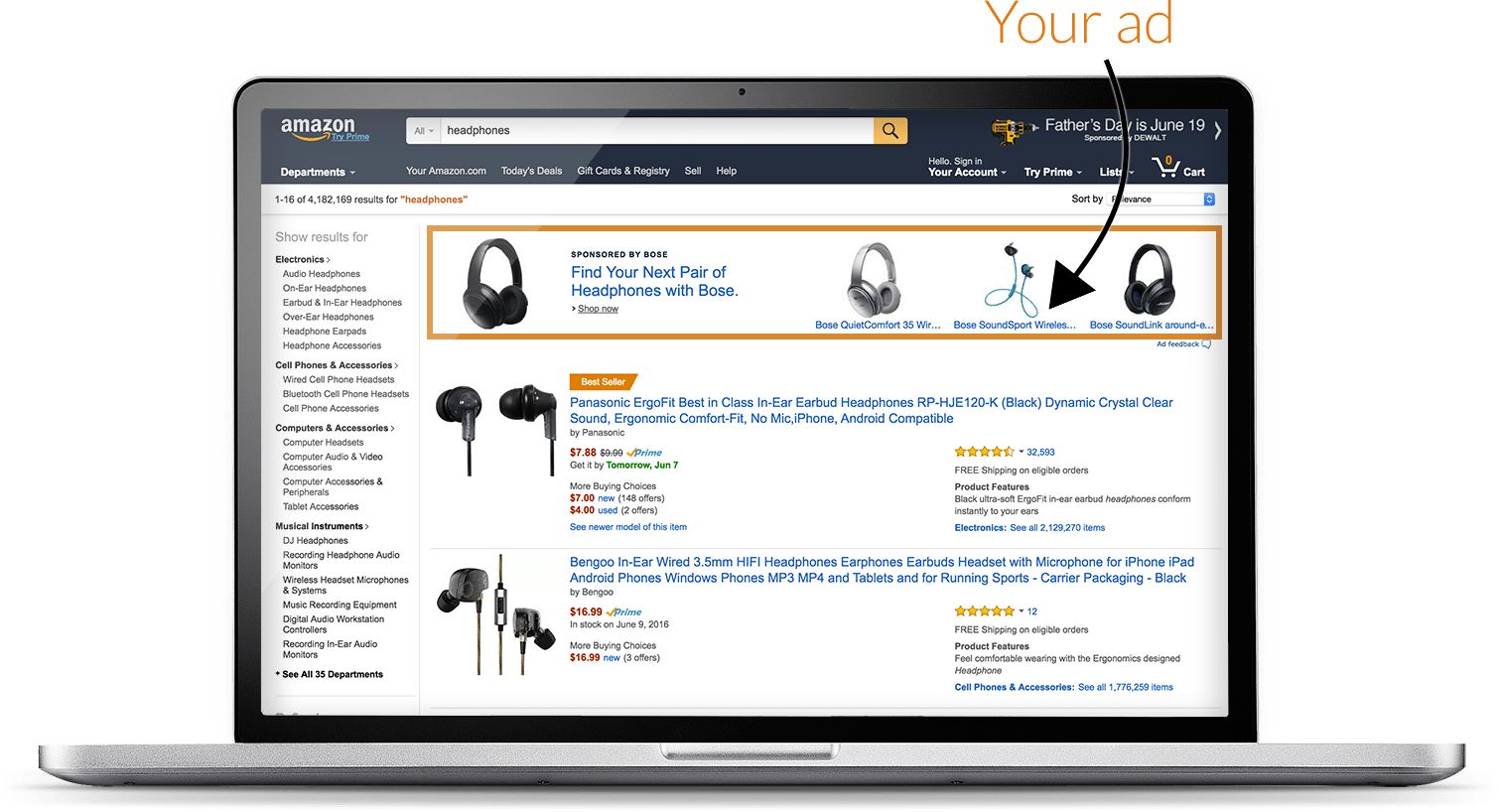 Reading Time: 4 minutes
Reading Time: 4 minutesAmazon is the world’s largest e-commerce retailer, earning a net profit of $3 billion after taxes in 2017. Other brands, however, can tap into Amazon’s enormous global market through Amazon pay-per-click (PPC) ad campaigns. Put your message in front of thousands of targeted audience members, all while enjoying one of the most cost-effective ways to advertise.
Some marketers get conversions using Amazon PPC ads for as little as one dollar per click. Amazon PPC might sound too good to be true, but it delivers real results for those who know how to use it to its full potential. Dig into how other marketers optimize their campaigns. Let the e-commerce giant work for you by putting your best foot forward on Amazon.com.
Find the Top-Converting Keywords
Amazon PPC platform isn’t quite as intuitive as Google AdWords when it comes to identifying the right keywords for your campaign. Unlike AdWords, the user will have to take a few steps to pull the relevant data from Amazon’s paid search platform. First, log into your Amazon Seller Central account. Go to the tab at the top of the page that says, “Reports,” then “Advertising Reports.” At the top of the page you’ll see different types of advertising reports you can access. Select “Search Term Report.”
The Search Term Report is where you’ll find your keyword data once you have a few Amazon PPC ads running. Download this data once every couple of months (the report shows you the past 60 days) to keep track of how your search terms and keywords are performing. Download the report, copy its text, and paste it into an Excel spreadsheet. Use the Excel feature PivotTable (under the Insert tab on a PC or the Data tab on a Mac) to paste the data into a new worksheet. Select the fields you wish to add to your new report from the PivotTable Field List provided.
Next, drag and drop the fields into areas according to how you wish to organize them. Click OK and you’ll have your PivotTable. Copy the whole table and paste into a new spreadsheet. Select “Paste Special” > “Paste Values” to change the formatting of the table so you can easily manipulate the data. From here, you can play with the data, organizing it and analyzing it to see which keywords to add and which to remove from your campaigns.
Uncover “Secret” Long-Tail Keywords
Long-tail keywords are vital for the success of your Amazon PPC campaigns and other marketing efforts. These specific keyword phrases can attract a significant amount of targeted search traffic – often traffic that’s already in the middle of the sales funnel. The right long-tail keywords for your PPC campaign, however, can be difficult to find. Use this three-step method from Franz Jordan, CEO of Sellics, to make it simple:
- Create an Amazon PPC automatic campaign. Download the Search Term Report and follow the steps listed above to make sense of the data. Locate your relevant search terms from the report.
- Use a tool such as Sellics’ Sonar to generate additional, long-tail keywords from the terms you located in your Search Term Report. Simply enter your shorter, simpler keyword and Sonar will do the rest for you.You can also use other apps, such as Scientific Seller, which uses latent semantic indexing to generate long-tail keywords from shorter ones for free. Scientific Seller will use keywords that buyers type specifically into Amazon to help inform your PPC campaign.
- Once you have your long-tail keywords, insert them naturally into your product listings and PPC ad content to become more visible on Amazon.
Finding untapped or “secret” long-tail keywords for your Amazon PPC ads can separate you from the competition and make your advertisements more visible to potential buyers. Use a healthy mix of regular and long-tail keywords in your content for the best results.
Master Amazon Ad Groups
Amazon PPC campaigns fall into ad groups. Knowing how to organize your groups can help you optimize your campaign. While there is no one-size-fits-all answer for ad grouping, you can customize your efforts based on your keywords and target audience. First, clean up ad structure. Structure all of your campaigns consistently. Choose the same structure for each of your campaigns (e.g., by product category or brand) to avoid creating repeat ads.
Create different ad groups according to the keyword. Your ad groups can and should include one main keyword as well as general keywords that are similar or in the same product category. For example, one ad group can contain both “workout equipment” and “workout gear” to keep up with which ads users will see for which keyword bids. Next, group similar products by your brand in the same ad group. All the items in your ad group should match the chosen keyword(s). Otherwise, your users won’t be able to find your products via searching for the keyword.
Use a Mix of Automatic and Manual Campaigns
Amazon offers two types of campaign for Sponsored Product Ads: automatic and manual. Automatic targeting asks sellers to simply name their budgets. Amazon will then do the work for the seller, finding keywords that match the desired category and product descriptions. Automatic campaigns are a great choice for marketers just starting out with Amazon PPC ads. They are also useful for identifying relevant keywords.
If it’s your first time using Amazon PPC, run a few automatic ads first. Let the ad run for a few days or weeks, and then evaluate the keywords that have converted into sales. Once you have a firm grasp on your best keywords through the automatic campaign, switch over to manual. Manual targeting offers benefits over automatic that can help marketers separate themselves from the pack.
The manual option requires sellers to select the keywords they wish to place bids on. If you’re more experienced with PPC and wish to target keywords more precisely, the manual option is for you. You can also test out keywords, measure performance, and make changes using the manual option. Using both types, at least at the beginning, can help inform your Amazon PPC strategy and build your keyword list. With a little practice, you’ll be able to master Amazon PPC advertising and see real results for your efforts.
At Vizion Interactive, we have the expertise, experience, and enthusiasm to get results and keep clients happy! Learn more about how our status as a Google Partner, along with our PPC Management, Google Shopping Ads, Social Media Advertising, Amazon Advertising, and other Paid Media services can increase sales and boost your ROI. But don’t just take our word for it, check out what our clients have to say, along with our case studies.




